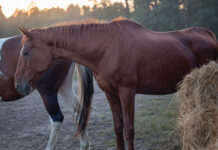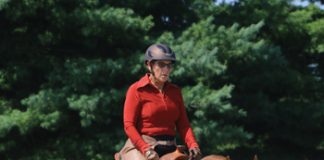
Q: I’ve been doing dressage with my horse for the past four years and we’ve been progressing slowly but steadily up the levels. She is now 19 and while she is generally sound and healthy, I’m starting to notice some symptoms of arthritis. For example, she seems to take a little longer to warm up than she used to. I wondered aloud the other day if I should consider backing off and maintain our current level instead of trying to progress further. My trainer said no, that if I’m riding her correctly, dressage will only help keep her joints and muscles strong as she ages. I know that light work is good for arthritis, but is that true for active dressage training? How much work is too much?

A: Don’t tell my horse, but I plan to continue to COMPETE him in dressage until he’s at least 20! So I guess I agree with your instructor that correctly ridden dressage is beneficial for horses and may help them age gracefully. Of course, your veterinarian is your other partner in this journey, and can help you determine your mare’s comfort level, what can be done to increase it, and when it might be time to back off, at least temporarily.
I started approaching this question from an equine scientist perspective and was already digging up research I’d seen on senior horse nutrition, exercise physiology, what specific changes happen in the horse’s body with age, and so on when it dawned on me. If you were asking about YOURSELF, what would the advice be?
Medical doctors and fitness experts tell us all the time that as we age, we lose muscular strength, bone density, and flexibility. What is dressage? Simply put, it’s muscle building and suppling! According to the USDF Glossary of Judging Terms, “suppleness” is defined as:
Range of motion of joints. Pliability, flexibility. The opposite of Stiffness. A horse’s suppleness is largely determined by genetics but may over time be improved or negatively impacted through training.
Doesn’t suppleness sound like something we want all of our horses to have, especially as they get older? The Glossary has lots of other terms and definitions that would be highly desirable in any horse but they are especially attractive when you think about older mounts:
- activity, amplitude
- balance, bend
- collection
- elasticity, engagement, extension
- flexibility, flexion, freedom
- impulsion
- lengthening, lightness, looseness
- mobility, movement
- on the forehand, over the back
- purity
- quality
- reach, regularity, relaxation, release, rhythm, roundness
- scope, self-carriage, straightness, swinging back
- throughness, tracking up
I invite you to read the definitions of these terms for yourself, as part of your dressage training and part of your training to be the caregiver of a senior horse.
Now for some words of warning. As much as the discipline has to offer, don’t get me wrong – dressage is a physically demanding sport, and each level you move up builds on this difficulty. You don’t mention what level you’re working at but beginning with Second Level and certainly by Third Level there is an expectation of uphill balance (collection), increased engagement (carrying power), and self-carriage. In addition, some gaits, movements, and transitions are more taxing than others, such as the extended trot and canter pirouette. So there may be days or there may come a time when a simple lengthening will suffice, or you choose trot-canter-trot transitions vs transitions that “skip a gear” such as walk-canter-walk. And while I love lateral work like the shoulder-in, haunches-in, renvers, and half pass to release the neck and access the back, it may not be necessary for every half pass to be as steep or collected as the test requires.
Good for you for noticing that your mare takes longer to warm up! Make sure you’re getting in a full ten minutes of walk (at least) before asking for faster work to give her aging body a chance to prepare for exertion to come. Likewise, she may appreciate a longer cool down too, to make sure the heart and respiratory rates have recovered, the body temperature has returned to normal, and the muscles and other soft tissues have returned to a relaxed state. Pay special attention to these phases and the schooling session itself when it’s particularly hot or cold, as older horses are less efficient at regulating their body temperature. Another tip is to provide regular, consistent work rather than random or weekend sessions as inconsistent exercise can lead to injury. Finally, since the older horse takes longer to return from time off, consider keeping your mare as active as possible year-round. You can certainly lighten the load from time to time or during the “off” season, but I advise against completely laying her off for a month (or more) because rebuilding the muscle, flexibility, and cardiopulmonary capacity takes more and more time as the years go by.
Congrats on what sounds like a wonderful horse, a wonderful instructor, and choosing a wonderful discipline of life-long learning!






